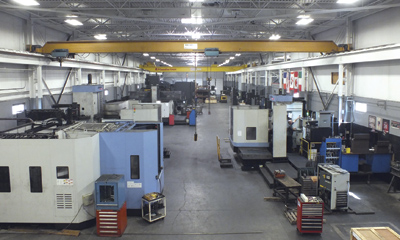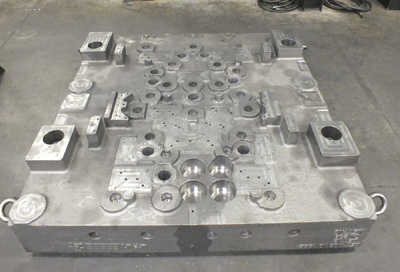by Kip Hanson
Buying the right machine for the job helps this Oldcastle machine shop prosper
THE PROBLEM: Insufficient machining capacity to meet customer demand
THE SOLUTION: Investment in a new and larger boring mill
Some shops buy a machine tool and then search for work to keep it busy. Vince Mainella finds the work and then gets the best machine to make the parts. And once a project has run its course, he’ll sell it and buy something else.
So when Mainella, co-owner of Rova Machine Inc., a job shop in Oldcastle, ON, needed a machine for a new order, he purchased a boring mill, the fourth and largest in his shop, a Doosan machine from machine tool distributor Ferro Technique, Mississauga. ON.
Mainella and his partner founded the company in 1995, recognizing there was an opportunity to manufacture precision components for the machine tool industry. Within two years, the company expanded into moulds, followed by large parts for the oil and gas industry, earthmoving machinery, die work, and more.
Today, Mainella and co-owner Andy Lombardi employ 20 people in their 2,200 sq m shop (24,000 sq ft). Rova produces a wide variety of custom machined parts, anything from a clamping fixture for transmission cases, to a rotary base for a mining dragline. And yes, they are still making products for the machine tool industry, many of which are machined on one of the company’s boring mills.
 “It’s tough for anyone to find good machinists these days, but for us it’s especially difficult,” Mainella says. “We are into so many different kinds of work, that one day you’ll be working on a mould, and the next day you’ll be working on a weldment, or a fixture, or a spindle…there’s just a wide variety of work that goes through the shop, and you need people that can adapt to that. It’s tough sometimes.”
“It’s tough for anyone to find good machinists these days, but for us it’s especially difficult,” Mainella says. “We are into so many different kinds of work, that one day you’ll be working on a mould, and the next day you’ll be working on a weldment, or a fixture, or a spindle…there’s just a wide variety of work that goes through the shop, and you need people that can adapt to that. It’s tough sometimes.”
Still, Mainella has no complaints. The local economy has remained steady, and the company is sufficiently diversified that there’s a constant flow of work coming through the door. “Around 35 per cent is mould and die-cast work, machine tool is probably 30 per cent, followed by tool and die, food industry, oil and gas—we’re busy all the time.”
To support the range of work the company does, the it uses an equally diverse array of machine tools and equipment. The Rova shop floor is home to a Makino A71 horizontal machining centre, a pair of SIP CNC jig borers boasting positional accuracy of 0.005 mm (0.0002 in.), an AGMA double column bridge mill with 3960 x 2640 mm table travel (156 x 104 in.), an assortment of saws, sinkers, and grinders, and four Doosans—three boring mills and one horizontal machining centre—purchased over the past several years from Ferro Technique Ltd..
“I’ve had a lot of boring mills over the years,” Mainella says. “I bought my first one in 1998. Then a few years ago one of our partners was retiring and we had to buy him out, so cash was a bit short that year. Still, we needed another machine, so I called Ferro president Brian Donnelly. He suggested we try one of the Doosans. ‘They’re a lot less money and they’re comparable to the machines you have now,’ he told me. It turned out that Brian was right. The Doosan was actually much stronger than our existing machines and just as accurate, so I ended up selling one of my old boring mills and bought another Doosan, and then another one after that.”
 Mainella says he’d always wanted to try a Doosan, but until then had opted for the machines he was used to. That’s all changed. He recently purchased his fourth boring mill—and Rova’s largest piece of equipment to date—a Doosan 130L-II. “That machine can really remove metal,” he says.
Mainella says he’d always wanted to try a Doosan, but until then had opted for the machines he was used to. That’s all changed. He recently purchased his fourth boring mill—and Rova’s largest piece of equipment to date—a Doosan 130L-II. “That machine can really remove metal,” he says.
He also likes the Doosan’s user-friendliness. Each machine has a Fanuc control, making it easy for operators to move from machine to machine. Everyone does their own programing on CAM-equipped shop floor workstations, then upload to the machine and start making chips. This arrangement has proven to be the most flexible for Rova’s eclectic low volume product mix, which rarely produces more than a half dozen parts in any given job.
Some might question a boring mill’s high price tag compared to a comparably-sized horizontal machining centre, but Mainella says those people don’t grasp the flexibility that comes with a large, W axis quill machine. “With a vertical machining centre, you’re limited to the top face. On a palletized machine like a horizontal, you’re limited to the size of the workpiece you can put on there. But a boring mill can run just about anything.”
He points to a current job as proof. “We’re running a relatively small part right now on our largest Doosan,” he says. “It measures roughly three feet wide and four feet long (900 x 1200 mm)—not even a quarter of the table. But the Doosan has a five-inch spindle (127 mm) that reaches everywhere you want to go. We can just drop the part in the middle of the table, rotate it around and do the whole job in one operation. It saves us a ton of time and effort.”
When asked what’s next for Rova, Mainella’s response is positive, if a bit expected for someone who is not afraid of new technology. “We’re always changing equipment,” he says. “We recently bought a new sinker for the EDM shop, but maybe we’ll bring in a small bridge machine next, or another boring mill. We’ll just have to see what kind of work comes through.” SMT
